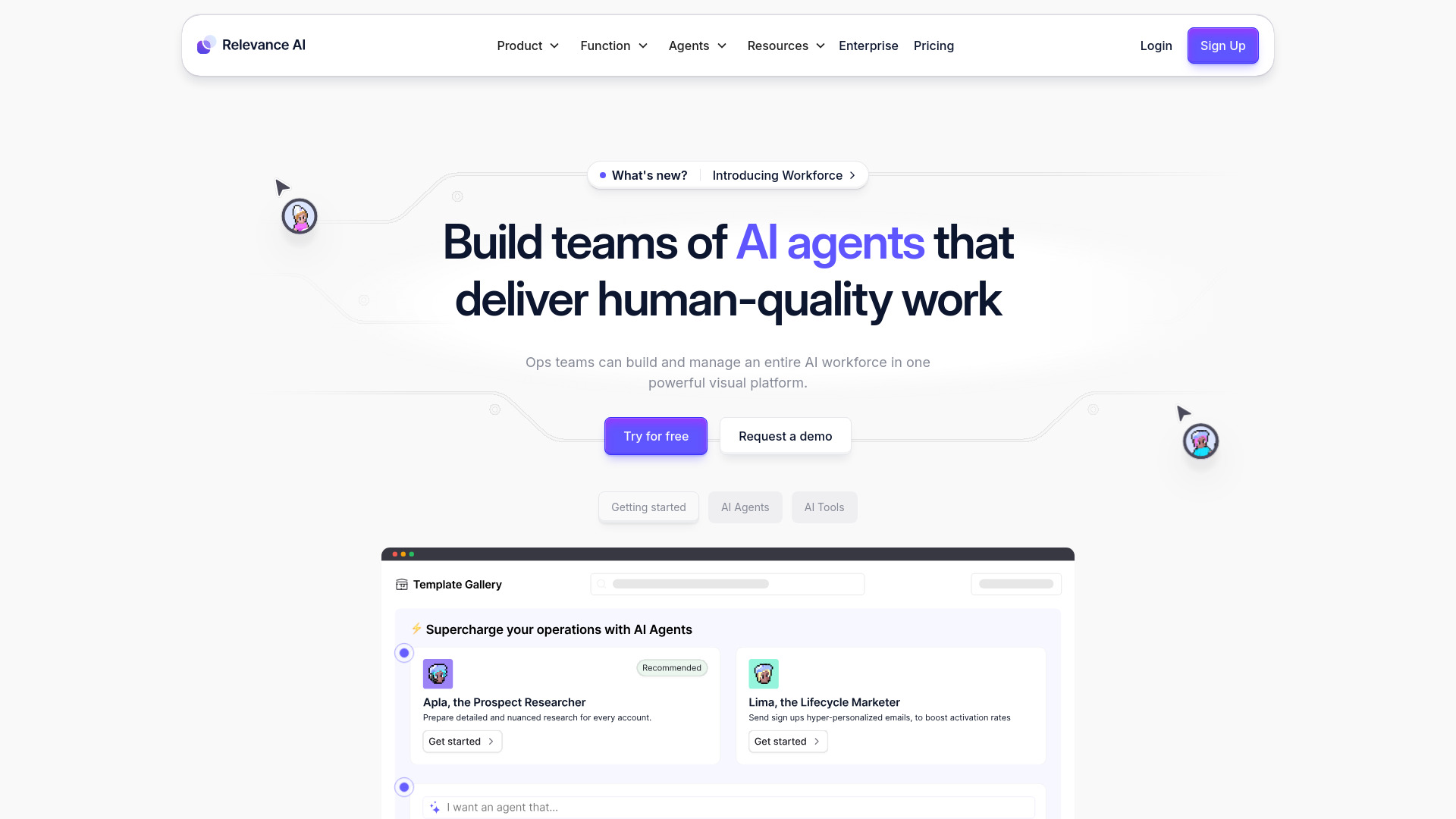- Home
- No-Code&Low-Code
- Relevance AI

Relevance AI
Open Website-
Tool Introduction:Relevance AI: build autonomous agent teams, automate workflows via API.
-
Inclusion Date:Oct 21, 2025
-
Social Media & Email:
Tool Information
What is Relevance AI
Relevance AI is the home of the AI Workforce, enabling teams to build, manage, and scale autonomous AI agents that put recurring processes on autopilot. It lets you create custom agents, connect them to organizational knowledge, capture rich metadata for monitoring, and trigger work via schedules or API calls. With built-in approvals for human-in-the-loop control, versioning, collaboration, and embeddable chat, Relevance AI helps organizations ship reliable, auditable automation while keeping workflows measurable and aligned with business rules.
Relevance AI Main Features
- Custom AI agents: Design role-specific agents tailored to your processes, policies, and KPIs.
- Agent orchestration: Coordinate multi-agent workflows with clear handoffs and dependencies.
- Knowledge integration: Provide curated knowledge so agents act with context and accuracy.
- API-triggered automation: Start and control agent runs via API to fit into existing systems.
- Scheduling: Run recurring jobs on time-based schedules for routine tasks.
- Approvals & human-in-the-loop: Insert reviews, sign-offs, and exceptions handling where needed.
- Metadata & observability: Capture inputs, outputs, and metrics for traceability and QA.
- Version control: Safely iterate on agents and workflows with rollbacks and change history.
- Collaboration: Share, comment, and co-develop agents across teams with standardized templates.
- Embeddable chat: Deploy agent chat interfaces in apps or sites to meet users where they work.
Who is Relevance AI For
Relevance AI is ideal for operations, product, and support teams looking to automate repeatable processes with autonomous agents while retaining governance. It suits data and engineering teams that need an API-first platform, and business teams seeking workflow automation for tasks like triage, content ops, research assistance, or approvals-heavy processes.
How to Use Relevance AI
- Define the process goal and identify steps suitable for agent automation and human review.
- Create a custom AI agent, specifying role, instructions, guardrails, and success criteria.
- Connect knowledge sources so the agent can reference approved context and data.
- Compose a workflow, adding multi-agent steps, branching, and approvals where required.
- Configure triggers: set a schedule or integrate API calls from your existing systems.
- Test in a sandbox, review metadata and outputs, and refine prompts or policies.
- Version and deploy to production, enabling collaboration with teammates.
- Monitor runs, capture feedback, and iterate using observability insights.
Relevance AI Industry Use Cases
In customer support, agents can triage tickets, draft responses, and escalate with approvals. In e-commerce, they can enrich product data, flag anomalies, and schedule price updates. Marketing teams can generate, review, and publish content with human-in-the-loop checkpoints. In operations, agents can reconcile records, prepare summaries, and trigger follow-up tasks via API—providing measurable, auditable automation across departments.
Relevance AI Pricing
Pricing typically depends on features, team size, and usage. For the most accurate and current information, including any free tiers or trials, please refer to the official Relevance AI website.
Relevance AI Pros and Cons
Pros:
- End-to-end agent lifecycle management from design to deployment.
- Robust approvals and human-in-the-loop control for governed automation.
- Strong observability with metadata capture for QA and compliance.
- Flexible triggers via schedules and API for seamless integration.
- Version control and collaboration support team-wide iteration.
- Embeddable chat enables contextual, user-facing agent experiences.
Cons:
- Initial learning curve to model processes as multi-agent workflows.
- Performance depends on quality of provided knowledge and guardrails.
- Integration work may be required to fit complex legacy systems.
- Ongoing monitoring is needed to maintain reliability as processes evolve.
Relevance AI FAQs
-
What is an AI Workforce in Relevance AI?
It is a coordinated set of autonomous agents that collaborate to execute end-to-end business processes with built-in oversight and approvals.
-
Can I trigger agents from my existing systems?
Yes. You can invoke agents via API triggers to fit automation into your current applications and data flows.
-
How do I keep outputs accurate and compliant?
Provide curated knowledge, define policies and guardrails, require approvals for critical steps, and use metadata to audit runs.
-
Does it support collaboration across teams?
Yes. Teams can co-develop agents, share versions, and manage changes with built-in collaboration and version control.
-
Where can I deploy agent chat?
You can embed chat experiences in your applications or websites to deliver contextual assistance powered by your agents.



